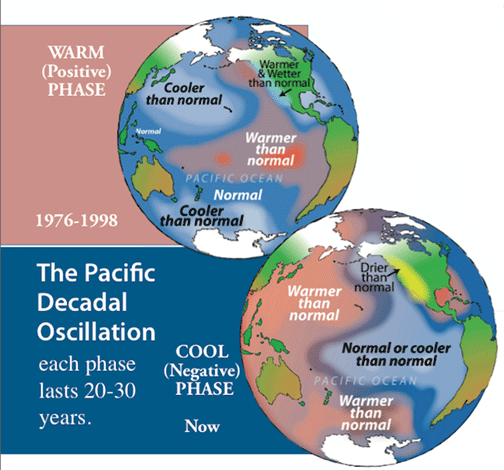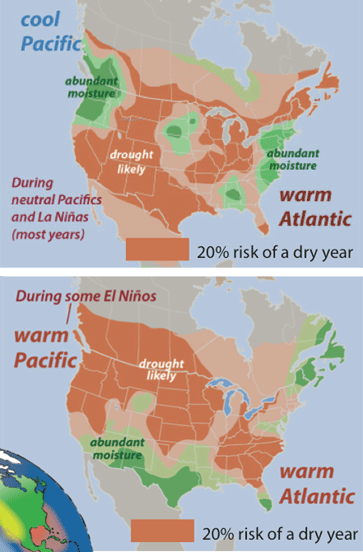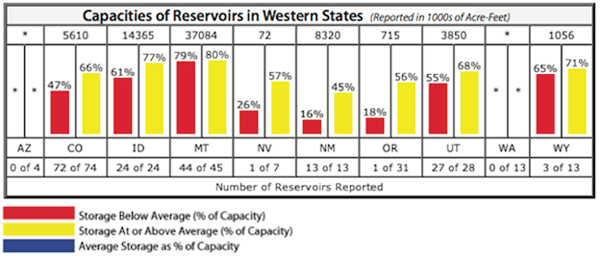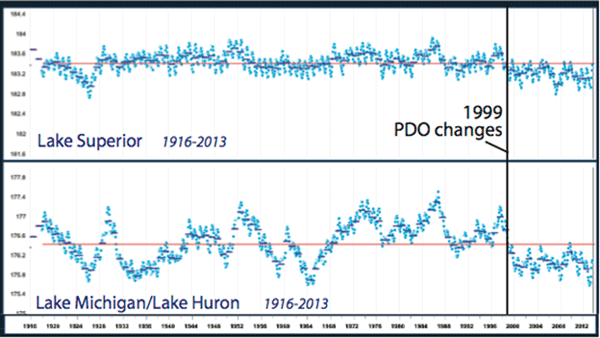Economic Consquences of Climate Change - The New Normal
Economics / Climate Change Aug 14, 2013 - 09:35 AM GMTBy: John_Mauldin
 Everybody talks about the weather, but there's not much we can do about it except make plans that take into account what mother nature may throw at us. For most of us that means planning for the next few days, but we should all be aware of climate patterns that are going to affect us for the next 20 to 30 years. And those patterns are changing not just because of global climate change but also due to long-term periodic changes in the Atlantic and Pacific oceans.
Everybody talks about the weather, but there's not much we can do about it except make plans that take into account what mother nature may throw at us. For most of us that means planning for the next few days, but we should all be aware of climate patterns that are going to affect us for the next 20 to 30 years. And those patterns are changing not just because of global climate change but also due to long-term periodic changes in the Atlantic and Pacific oceans.
Look at what my friend and one of the world's preeminent climatologists Evelyn Browning Gariss writes:
The "New Normal" [climate pattern], with a warm Atlantic and a Pacific that tends to be cool (interrupted by El Niños) is changing US temperature and precipitation patterns. This in turn has had a major impact on sectors of the US economy. Remember, companies doing long-term planning often use records that are only 25 to 30 years in duration. The PDO tipped only 7 years ago. Most of the records that are used by policy-makers are biased towards times when the PDO was wetter than it is today. This has resulted in mistaken ideas of how rare a weather event may be. We saw what a potential disaster this 25-30 year approach could be when NOAA tropical storm concerns were brushed aside by New York and New Jersey because there had been no landfalls since the 1950s.
We are dealing with the same Atlantic and Pacific configurations that shaped the 1950s. Our economy and society will have to learn to cope with this New Normal.
Evelyn is the daughter of Ibn Browning, who for decades was one of the leading climatologists in America, and she has carried on that proud tradition. I regularly read her work and factor it into my thinking. If you like what you find in the special excerpt from The Browning Newsletter that Evelyn and colleagues have prepared for this week's Outside the Box, you can learn more and subscribe here.
Note that if you invest in companies or run your own business, where long-term and seasonal climate and weather movements can make a difference and you are not consulting with serious climatologists you are (as I used to tell my kids when they were growing up) just "cruising for a bruising."
As this note on the climate is brief, I want to commend to you something that will let you take action on another important, long-term problem, that of growing unfunded federal government liabilities. My friend Lawrence Kotlikoff has been doing yeoman work drafting legislation for which he has now lined up significant bipartisan support in Congress. This bill would require congressional budgeting offices to actually state the long-term fiscal impact of current legislation on future generations. He also has support of 12 Nobel laureates and over 500 economists, who represent as broad a spectrum of economic thinking as you will find today.
This generation of Americans is very likely to be the first generation in our history as a nation to leave a worse economy and a worse fiscal position than the one they inherited. The INFORM ACT is a step in the right direction toward informing Americans of the magnitude of this problem." – James Heckman, Nobel Laureate in Economics
I offer Kotlikoff's summary of the Inform Act at the conclusion of this Outside the Box and urge you to go to http://www.theinformact.org/ and sign up yourself and pass the word to your friends and associates. If you have contacts in Congress, then get them to add their names to the bill. No Congressman will be able to publicly oppose this bill, although privately many of them will be horrified that their constituents and especially young people may begin to learn the truth.
I find myself happily ensconced on Flathead Lake in Montana. I'm with my friend Darrell Cain, and we're looking out over the lake at the magnificent Rockies. The weather is about as perfect as it can get. They don't call this region the Big Sky Country for nothing. The night sky is unbelievable, and from the deck you're looking directly up into the Pleiades in the middle of the annual meteor shower. It is spectacular up here. And for the first time in my life I saw the International Space Station fly past. It was clearly the brightest object in the sky, and due to its motion opposite the Earth's rotation, it appeared to be screamingly fast. And it is fast! 17,500 mph and an orbit of the Earth every 92 minutes. It went from horizon to horizon in just a few minutes.
I will be here another four days, and I can see why Darrell has come here every summer for the last 10 years and is now here with his extended family. This is a slice of heaven. But today is the last day with the family, and then it's just me, Darrell, and ETF trading maven Steve Cucchiaro, founder of Windhaven. It will be interesting to see what I write this week, after I've had a little time to relax and think.
Finally, let me commend a couple short articles written by my friend Barry Ritholtz: "On the Value of Not Knowing" and "10 reasons why economics is an art, not a science."
And with that it's time to go ahead and hit the send button.
You're trying to introduce myself to the concept of relaxing analyst,
John Mauldin, Editor
Outside the Box
JohnMauldin@2000wave.com
The New Normal — Some Expensive Consequences
Excerpted from The Browning Newsletter, August 2013, Vol. 38, No. 8
SUMMARY
From the Western wildfires to the Great Lakes, from insurance to transportation, real estate values, and fuel, the "New Normal" is having a major negative impact on certain sectors of the North American economy.
Long-term planning, using 20+ years of data, is biased towards climate conditions that no longer exist. If long-term planners look at 60-80 years of climate data, they should make different and better decisions.
Climate change is affecting the bottom line. The changes in two long-term trends are raising costs and cutting profits for a number of industries. As long as each bad year is accepted as a one-off, rather than the New Normal, these "unexpected" losses will continue.
• THE ATLANTIC – The waters in the Gulf Stream are flowing faster, carrying more hot tropical waters along US shores.
• THE PACIFIC – The Pacific has a 50-60 year cycle, called the Pacific Decadal Oscillation (PDO), that shifts warmer waters through the Northern Pacific. Starting in 1999 and tipping in 2006, the PDO has shifted cooler waters to US shores. Although occasionally interrupted by a warm El Niño, this creates drier Western weather. [Figure 1]
History shows that both trends will last another 15 to 20 years. We are starting to see the impact of these changes.

figure1
Most models include weather patterns from the era when the Pacific Decadal Oscillation was positive. Now it is negative, creating drier conditions in Western North America. ©Evelyn Garriss Browning
Wildfires: "Not Every House Should Be Saved"
When the PDO changed to its negative phase, the West became drier. Forest densities that were appropriate during the wet positive phase are too dense in drier times. The trees in the tightly packed forests became stressed, leaving them more susceptible to disease, insect infestations, and wildfires. Policies that were adequate for managing the wilderness in the wet phase of the PDO do not work now. This has led to disastrous megafires in the Western states. As noted by Bill Gabbart of Wildfire Today, "Six of the last 9 years had more burned acres than in any year between 1960 and 2003."
This is not just a Western problem. [Figure 2] The cold PDO magnifies the impact of cool La Niñas. This, combined with the warm Atlantic, has made drought more common in the South and Midwest. Wildfires, if not megafires, have become more common in these areas as well.

figure 2
Since the Atlantic warmed in 1995, North America has faced a greater risk of drought. With a negative PDO (cool Pacific), the Southwest, Rocky Mountains, Southern Plains, and Midwest face greater risk of drought. US data: USGS ©Evelyn Garriss Browning
Policies and Insurance
When the PDO turned warm and wet in the 1970s, there was a national surge in home building in what is known as the Wildland/Urban Interface (WUI). According to a 2005 report cited by the Forest Service, some 32 percent of US housing units and 10 percent of all land with housing are situated in the WUI fire-prone ecosystems.
The cost of fighting these fires is soaring – since 2000 the national price tag has tripled to $3 billion. In 1991, firefighting took up 13% of the Forest Service budget. Last year it consumed 40%. Meanwhile, firefighters are changing their strategies toward the WUI communities. Firefighters now focus on protecting the community rather than putting out the fire. The wildfire thins out the underbrush in the surrounding wilderness. Less mentioned is the strategy of declaring extremely fire-vulnerable houses indefensible and refusing to commit crews to some high-risk firescapes with limited values.
As forest fire fighting has increasingly focused on protecting communities and private property and costs have increased, there have been growing demands that property owners pay for the services and/or be discouraged from developing in WUI areas.
With federal policy increasingly defining forest fire damage to property as a natural disaster, similar to hurricanes and floods, property owners in Woodland/Urban Interface zones, 32% of all US housing units, can expect to see mounting insurance rates. This is happening in an already struggling housing market.
Western Water Levels: Electricity and Irrigation
At the beginning of August, only Montana's reservoirs were at or above capacity [Figure 3], while those of four Western states (Colorado, Nevada, New Mexico, and Oregon) were running at less than 50% capacity. The official measurements are not yet out, but reservoir levels have continued to decline.

figure3 Western Reservoirs have been lower since the PDO began changing in 1999.
When water levels are low, the division of stored water reserves is determined by politics. Remember, obscure endangered fish and wealthy country clubs have more political clout than farms. In the current drought, California's Central Valley Project is allotting only 20% of its water to farmers, and unless there's a wet winter coming up, they might get 0% next year.
Studies show that Western droughts and lower reservoir levels affect coal and nuclear electrical facilities as well as hydroelectricity. (Coal and nuclear generators need water for cooling.) Previous Western droughts reduced hydroelectricity production by 13.2%, raising energy costs by 9.5%.
Great Lakes Water Levels
The Western US is not the only region with low lake levels. Lakes Michigan and Huron set new record-low water levels last December, while the other Great Lakes dropped as well. Although some of this is due to the low snowfall levels of the winter of 2011/2012, the real problem is that the lakes have endured 14 years of below-average levels. [Figure 4]

figure 4 Selected Great Lakes water levels: 1916-2013. For the last 14 years, Great Lakes water levels have been severely reduced since 1999. This historically correlates to the negative PDO. http://www.glerl.noaa.gov/data/now/wlevels/levels.html
There is no scientific literature that ties the lower Great Lakes levels to the negative PDO, but the two correlate historically. If the negative PDO is a large factor in reducing water levels, then these lower levels will continue another 20 years.
The economic impact of these falling levels is hard to overstate. The lower levels pose economic threats to numerous industries that rely on the lakes' water supply, including, shipping, electric, (especially hydroelectric) power generation, tourism, and recreational boating.
Both US and Canadian industries that rely on bulk materials such as iron ore, coal, limestone, and salt are hugely dependent on lake travel. Lakers move products at prices that beat rail or road by as much as $20 per ton of cargo. Lower lake levels, however, force ships to lighten their loads, making hauling less efficient. It is estimated, for example, that a large laker, 1,000 feet long, would ship 324,000 fewer tons per season for each inch lost from Great Lake levels.
The lower Great Lakes levels, combined with hotter summer temperatures, have had serious impacts on energy production. The cost of shipping coal has increased, and a recent Department of Energy study reports that multiple Midwestern electrical plants have been affected. Oil, coal, gas, and nuclear generators that depend on the lakes' waters for cooling have seen lower water levels and higher temperatures affect their efficiency, which in turn has raised the cost of electricity to consumers.
Conclusion
The "New Normal," with a warm Atlantic and a Pacific that tends to be cool (interrupted by El Niños) is changing US temperature and precipitation patterns. This in turn has had a major impact on sectors of the US economy.
Remember, companies doing long-term planning often use records that are only 25 to 30 years in duration. The PDO tipped only 7 years ago. Most of the records that are used by policy-makers are biased towards times when the PDO was wetter than it is today. This has resulted in mistaken ideas of how rare a particular weather event may be. We saw what a disaster this 25-30 year approach could be when NOAA tropical storm concerns were brushed aside by New York and New Jersey because there had been no landfalls since the 1950s.
We are dealing with the same Atlantic and Pacific configurations that shaped the 1950s. Our economy and society will have to learn to cope with this New Normal.
This generation of Americans is very likely to be the first generation in our history as a nation to leave a worse economy and a worse fiscal position than the one they inherited. THE INFORM ACT is a step in the right direction toward informing Americans of the magnitude of this problem." – James Heckman, Nobel Laureate in Economics
Dear Fellow Economists and Other Fellow Citizens,
Please join the 12 Nobel Laureates in Economics, prominent former government officials, and others listed here in endorsing the INFORM ACT.
The INFORM ACT requires the Congressional Budget Office (CBO), the General Accountability Office (GAO), and the Office of Management and Budget (OMB) to do fiscal gap accounting and generational accounting on an annual basis and, upon request by Congress, to use these accounting methods to evaluate major proposed changes in fiscal legislation.
The INFORM ACT is a bi-partisan initiative. The bill was introduced Senators Kaine (Democrat from Virginia) and Senator Thune (Republican from South Dakota) and is being co-sponsored by Senator Coons (Democrat from Delaware) and Senator Portman (Republican from Ohio). The Bill will shortly be introduced on a bi-partisan basis in the House of Representatives.
Background
The fiscal gap is a comprehensive measure of our government's indebtedness. It is defined as the present value of all projected future expenditures, including servicing outstanding official federal debt, less the present value of all projected future tax and other receipts, including income accruing from the government's current ownership of financial assets.
Generational accounting measures the burden on today's and tomorrow's children of closing the fiscal gap assuming that current adults are neither asked to pay more in taxes nor receive less in transfer payments than current policy suggests and that successive younger generations' lifetime tax payments net of transfer payments received rise in proportion to their labor earnings.
Neither fiscal gap nor generational accounting are perfect measures of fiscal sustainability or generation-specific fiscal burdens. But they offer significant advantages relative to conventional measures of official debt. First, they are comprehensive and forward-looking. Second, they are based on the government's intertemporal or long-term budget constraint, which is a mainstay of economic models of fiscal policy. Third, neither generational accounting nor fiscal gap accounting leave anything off the books.
Fiscal gap accounting and generational accounting have been done for roughly 40 developed and developing countries either by their treasury departments, finance ministries, or central banks, or by the IMF, the World Bank, or other international agencies, or by academics and think tanks. Fiscal gap accounting is not new to our own government. The Social Security Trustees and Medicare Trustees have been presenting such calculations for their own systems for years in their annual reports. And generational accounting has been included in the President's Budget on three occasions.
According to recent IMF and CBO projections, the U.S. fiscal gap is far larger than the official debt and compounding very rapidly. The longer we wait to close the fiscal gap, the more difficult will be the adjustment for ourselves and for our children. This said, acknowledging the government's fiscal gap and deciding how to deal with it does not rule out productive government investments in infrastructure, education, research, or the environment, or in pro-growth tax reforms.
Your endorsement, together with those of the Nobel Laureates and former high-level government officials, will be included in an open letter to Congress, which will be printed in the New York Times in a full page ad in the Fall. A copy of the letter is provided on this site.
Please Endorse the INFORM ACT by clicking on the ENDORSE tab on [our] site. Please also forward the url to this site, tweet it, like it, share it and do anything else you can to encourage other economists and concerned citizens to endorse the INFORM ACT.
With deep appreciation for your consideration of this request,
Larry Kotlikoff Professor of Economics, Boston University
John Mauldin
subscribers@MauldinEconomics.com
Outside the Box is a free weekly economic e-letter by best-selling author and renowned financial expert, John Mauldin. You can learn more and get your free subscription by visiting www.JohnMauldin.com.
Please write to johnmauldin@2000wave.com to inform us of any reproductions, including when and where copy will be reproduced. You must keep the letter intact, from introduction to disclaimers. If you would like to quote brief portions only, please reference www.JohnMauldin.com.
John Mauldin, Best-Selling author and recognized financial expert, is also editor of the free Thoughts From the Frontline that goes to over 1 million readers each week. For more information on John or his FREE weekly economic letter go to: http://www.frontlinethoughts.com/
To subscribe to John Mauldin's E-Letter please click here:http://www.frontlinethoughts.com/subscribe.asp
Copyright 2013 John Mauldin. All Rights Reserved
Note: John Mauldin is the President of Millennium Wave Advisors, LLC (MWA), which is an investment advisory firm registered with multiple states. John Mauldin is a registered representative of Millennium Wave Securities, LLC, (MWS), an FINRA registered broker-dealer. MWS is also a Commodity Pool Operator (CPO) and a Commodity Trading Advisor (CTA) registered with the CFTC, as well as an Introducing Broker (IB). Millennium Wave Investments is a dba of MWA LLC and MWS LLC. Millennium Wave Investments cooperates in the consulting on and marketing of private investment offerings with other independent firms such as Altegris Investments; Absolute Return Partners, LLP; Plexus Asset Management; Fynn Capital; and Nicola Wealth Management. Funds recommended by Mauldin may pay a portion of their fees to these independent firms, who will share 1/3 of those fees with MWS and thus with Mauldin. Any views expressed herein are provided for information purposes only and should not be construed in any way as an offer, an endorsement, or inducement to invest with any CTA, fund, or program mentioned here or elsewhere. Before seeking any advisor's services or making an investment in a fund, investors must read and examine thoroughly the respective disclosure document or offering memorandum. Since these firms and Mauldin receive fees from the funds they recommend/market, they only recommend/market products with which they have been able to negotiate fee arrangements.
Opinions expressed in these reports may change without prior notice. John Mauldin and/or the staffs at Millennium Wave Advisors, LLC and InvestorsInsight Publishing, Inc. ("InvestorsInsight") may or may not have investments in any funds cited above.
Disclaimer PAST RESULTS ARE NOT INDICATIVE OF FUTURE RESULTS. THERE IS RISK OF LOSS AS WELL AS THE OPPORTUNITY FOR GAIN WHEN INVESTING IN MANAGED FUNDS. WHEN CONSIDERING ALTERNATIVE INVESTMENTS, INCLUDING HEDGE FUNDS, YOU SHOULD CONSIDER VARIOUS RISKS INCLUDING THE FACT THAT SOME PRODUCTS: OFTEN ENGAGE IN LEVERAGING AND OTHER SPECULATIVE INVESTMENT PRACTICES THAT MAY INCREASE THE RISK OF INVESTMENT LOSS, CAN BE ILLIQUID, ARE NOT REQUIRED TO PROVIDE PERIODIC PRICING OR VALUATION INFORMATION TO INVESTORS, MAY INVOLVE COMPLEX TAX STRUCTURES AND DELAYS IN DISTRIBUTING IMPORTANT TAX INFORMATION, ARE NOT SUBJECT TO THE SAME REGULATORY REQUIREMENTS AS MUTUAL FUNDS, OFTEN CHARGE HIGH FEES, AND IN MANY CASES THE UNDERLYING INVESTMENTS ARE NOT TRANSPARENT AND ARE KNOWN ONLY TO THE INVESTMENT MANAGER.
John Mauldin Archive |
© 2005-2022 http://www.MarketOracle.co.uk - The Market Oracle is a FREE Daily Financial Markets Analysis & Forecasting online publication.



